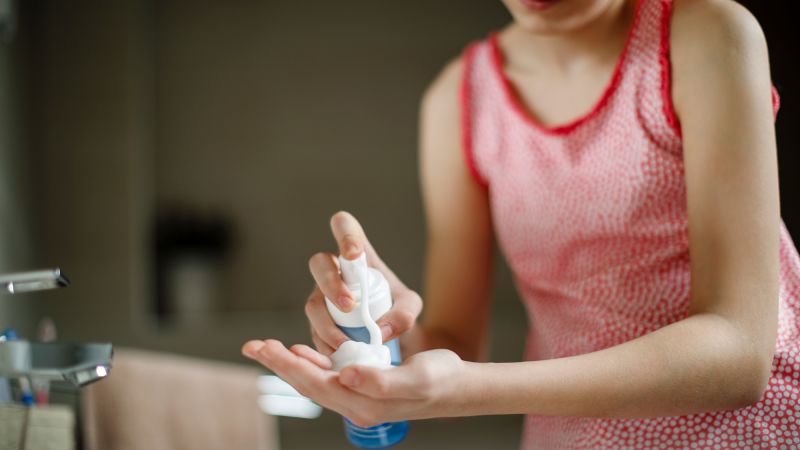Teen TikTok skin care craze may be harmful — and expensive, study finds – CNN
Source: CNN
Get inspired by a weekly roundup on living well, made simple. Sign up for CNN’s Life, But Better newsletter for information and tools designed to improve your well-being.
When Ayva Peña got a phone at age 10, her interest in skin care skyrocketed.
At first, she bonded over it with her mother, Giselle Peña. Together, they would have spa days with face masks and take occasional shopping trips to try out new products. But when the Rhode Island mother found a $300 anti-aging face cream in Ayva’s medicine drawer, it gave her pause.
“I got very upset. … She’s 15 years old,” Peña said. “It says it makes your skin ageless, improves fine lines, wrinkles and firmness. I was like, ‘This is not for you, girl.’”
Peña is among a growing number of parents concerned about how content on social media platforms is influencing children and teens into trying out elaborate, often age-inappropriate skin care products. Now, a study published Monday in the journal Pediatrics may confirm those parents’ worries.
Teens are delaying getting their driver’s licenses. Parents want to know why
After analyzing beauty routines from 100 TikTok videos by content creators ages 7 through 18, researchers found an average of 11 potentially irritating active ingredients among their regimens, many of which carry a risk of developing skin allergies and increased sun sensitivity. Only a quarter of the lengthy product lists contained sunscreens, however.
“The majority of (children) featured in these videos didn’t have any visible acne. They had perfect, clear skin,” said Dr. Molly Hales, the first study author and a board-certified dermatologist in the department of dermatology at Northwestern University’s Feinberg School of Medicine. “For many of them, the harms probably outweigh any potential benefits.”
Between the dozens of daily serums, moisturizers, toners and cleansers featured in the videos, the average routine was six steps long, costing about $168 — with some more than $500 — for one month’s worth of product, according to the study.
“When you have kids waking up at 5:30 in the morning on a school day to have enough time to layer on these complicated regimens, I think it becomes less about health and more (about) pursuing an idea of beauty that is unrealistic and problematic,” said Hales, who is also a postdoctoral research fellow at Feinberg. The findings raise serious ethical questions about how social media content influences young people in their everyday lives, she added
A TikTok spokesperson, noting that this type of content is “common across all media,” said the platform is only for users ages 13 and older, and any creators suspected to be under 13 are removed. Additionally, they said that TikTok works with third-party doctors and experts in adolescent development to implement safeguarding policies.
Most of the studied skin care routines lacked a form of sunscreen but contained products that could increase sun sensitivity and risk of skin cancer, the authors found.
Common active ingredients found in recommended skin products were alpha hydroxy acids or AHAs, mild chemical exfoliants that help remove top layers of skin cells, Hales said. While they have the intended effect of evening skin tone and creating a more youthful appearance, they are known to make the skin more vulnerable to the sun’s ultraviolet rays.
“I would recommend daily sunscreen use for all ages and regimens, but especially for those using these (AHAs),” Hales said. “It’s a necessary step to prevent permanent skin damage.”
Only one-quarter of sunscreens on store shelves are safe and effective, new report says
Those AHAs, as well as vitamin-based ingredients such as niacinamide, are also considered potential irritants, carrying side effects such as redness and dryness, especially with overuse.
“In many cases, the girls may not have realized they were applying the same active ingredient again and again, which just increases the risk of irritation,” said Dr. Tara Lagu, senior study author and adjunct lecturer of medicine and medical social sciences at Feinberg.
More than half the products contained fragrance — a common cause of allergic contact dermatitis — and 20 other inactive ingredients that are known allergens, according to the study.
“Misinformation is a big issue on social media, but especially for these content creators younger than 18,” said Dr. Sonal Shah, a board-certified dermatologist in Cleveland and director of pediatric dermatology at University Hospitals Rainbow Babies & Children’s Hospital. Shah was not involved in the study.
“These are sources that perhaps don’t have a scientific background and are not well read in the science behind a lot of these produ
Read more: Click here
